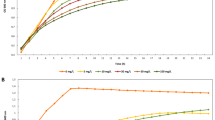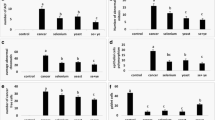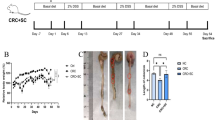Abstract
This study aimed to screen a mutant of Candida utilis SE-172 with high selenite tolerance and glutathione (GSH) biosynthesis capability via 60Co γ-radiation mutagenesis to prepare selenium (Se)-enriched yeast. The maximal intracellular contents of GSH and organic Se of 22.94 mg/g and 1308.1 μg/g were obtained, respectively, under a batch culture of SE-172. The physiological mechanism underlying increased GSH and organic Se contents in Se/GSH-enriched C. utilis SE-172 was revealed based on assaying activities of γ-glutamylcysteine synthase (γ-GCS) involved in GSH biosynthesis and selenophosphate synthase (SPS) related to organic Se bioconversion, and by determining intracellular ATP and NADH contents and ATP/ADP and NADH/NAD+ ratios associated with energy supply and regeneration. Moreover, the effect of this selenized yeast on anti-inflammatory and antioxidant activities in mice with colitis was investigated. The supplementation of Se/GSH-enriched yeast decreased the dextran sodium sulfate-induced damage to colon tissues, reduced the expression of pro-inflammatory factors [interleukin (IL)-6, IL-1β, and tumor necrosis factor-α (TNF-α)] in serum, increased the antioxidant-related enzyme [superoxide dismutase (SOD), catalase (CAT), and glutathione peroxidase (GSH-Px)] activities, and decreased the malondialdehyde content in colon. The Se/GSH-enriched C. utilis SE-172 showed potent anti-inflammatory and antioxidant activities in mice with colitis.






Similar content being viewed by others
Data availability
The data are available by the corresponding author upon a reasonable query.
References
D'Amato R, Regni L, Falcinelli B, Mattioli S, Benincasa P, Dal Bosco A, Pacheco P, Proietti P, Troni E, Santi C, Businelli D (2020) Current knowledge on selenium biofortification to improve the nutraceutical profile of food: a comprehensive review. J Agric Food Chem 68(14):4075–4097
Kieliszek M, Bano I, Zare H (2022) A comprehensive review on selenium and its effects on human health and distribution in middle eastern countries. Biol Trace Elem Res 200(3):971–987
Ying H, Zhang Y (2019) Systems biology of selenium and complex disease. Biol Trace Elem Res 192(1):38–50
Duntas LH (2009) Selenium and inflammation: underlying anti-inflammatory mechanisms. Horm Metab Res 41(6):443–447
Pons DG, Moran C, Alorda-Clara M, Oliver J, Roca P, Sastre-Serra J (2020) Micronutrients selenomethionine and selenocysteine modulate the redox status of MCF-7 breast cancer cells. Nutrients 12(3):865
Nie XL, Xing Y, Li QF, Gao F, Wang SY, Liu P, Li XQ, Tan ZB, Wang PX, Shi H (2022) ARTP mutagenesis promotes selenium accumulation in Saccharomyces boulardii. LWT 168(10):113916
Mapelli V, Hillestrøm PR, Kápolna E, Larsen EH, Olsson L (2011) Metabolic and bioprocess engineering for production of selenized yeast with increased content of seleno-methylselenocysteine. Metab Eng 13:282–293
Yang J, Yang H (2023) Recent development in Se-enriched yeast, lactic acid bacteria and bifidobacteria. Crit Rev Food Sci Nutr 63(3):411–425
Abedi J, Saatloo MV, Nejati V, Hobbenaghi R, Tukmechi A, Nami Y, Khosroushahi AY (2018) Selenium-enriched Saccharomyces cerevisiae reduces the progression of colorectal cancer. Biol Trace Elem Res 185(2):424–432
Guo H, Guo S, Liu H (2020) Antioxidant activity and inhibition of ultraviolet radiation-induced skin damage of selenium-rich peptide fraction from selenium-rich yeast protein hydrolysate. Bioorg Chem 105:104431
Guo H, Li M, Liu H (2022) Selenium-rich yeast peptide fraction ameliorates imiquimod-induced psoriasis-like dermatitis in mice by inhibiting inflammation via MAPK and NF-κB signaling pathways. Int J Mol Sci 23(4):2112
Suhajda A, Hegóczki J, Janzsó B, Pais I, Vereczkey G (2000) Preparation of selenium yeasts I. preparation of selenium-enriched Saccharomyces cerevisiae. J Trace Elem Med Biol 14(1):43–47
Chasteen TG, Bentley R (2003) Biomethylation of selenium and tellurium: microorganisms and plants. Chem Rev 103:1–25
Ding H, Li J, Deng F, Huang S, Zhou P, Liu X, Li Z, Li D (2023) Ammonia nitrogen recovery from biogas slurry by SCP production using Candida utilis. J Environ Manag 325(1):116657
Kieliszek M, Bierla K, Jiménez-Lamana J, Kot AM, Alcántara-Durán J, Piwowarek K, Błażejak S, Szpunar J (2020) Metabolic response of the yeast Candida utilis during enrichment in selenium. Int J Mol Sci 21(15):5287
Wang D, Yang B, Wei G, Liu Z, Wang C (2012) Efficient preparation of selenium/glutathione-enriched Candida utilis and its biological effects on rats. Biol Trace Elem Res 150(1-3):249–257
Nemmiche S (2017) Oxidative signaling response to cadmium exposure. Toxicol Sci 156(1):4–10
Bansal A, Simon MC (2018) Glutathione metabolism in cancer progression and treatment resistance. J Cell Biol 217(7):2291–2298
Yu Q, Li Y, Wu B, Hu W, He M, Hu G (2020) Novel mutagenesis and screening technologies for food microorganisms: advances and prospects. Appl Microbiol Biotechnol 104(4):1517–1531
Wang H, Sim MK, Loke WK, Chinnathambi A, Alharbi SA, Tang FR, Sethi G (2017) Potential protective effects of ursolic acid against gamma irradiation-induced damage are mediated through the modulation of diverse inflammatory mediators. Front Pharmacol 8:352
Iddar A, El Mzibri M, Moutaouakkil A (2022) Effects of the cobalt-60 gamma radiation on Pichia pastoris glyceraldehyde-3-phosphate dehydrogenase. Int J Radiat Biol 98(2):244–252
Vanhoudt N, Vandenhove H, Horemans N, Wannijn J, Van Hees M, Vangronsveld J, Cuypers A (2010) The combined effect of uranium and gamma radiation on biological responses and oxidative stress induced in Arabidopsis thaliana. J Environ Radioact 101(11):923–930
Maremonti E, Eide DM, Oughton DH, Salbu B, Grammes F, Kassaye YA, Guédon R, Lecomte-Pradines C, Brede DA (2019) Gamma radiation induces life stage-dependent reprotoxicity in Caenorhabditis elegans via impairment of spermatogenesis. Sci Total Environ 695(3-4):133835
Reisz JA, Bansal N, Qian J, Zhao W, Furdui CM (2014) Effects of ionizing radiation on biological molecules-mechanisms of damage and emerging methods of detection. Antioxid Redox Signal 21(2):260–292
Shao N, Wang D, Wei G, Zhang Q, Ge X, Nie M (2010) Screening of Candida utilis and medium optimization for co-production of S-adenosylmethionine and glutathione. Korean J Chem Eng 27:1847–1853
Zhang GC, Wang DH, Wang DH, Wei GY (2017) The mechanism of improved intracellular organic selenium and glutathione contents in selenium-enriched Candida utilis by acid stress. Appl Microbiol Biotechnol 101(5):2131–2141
Tietze F (1969) Enzymic method for quantitative determination of nanogram amounts of total and oxidized glutathione: applications to mammalian blood and other tissues. Anal Biochem 27(3):502–522
Hao S, Teng B (1999) Study on determination of selenium in selenium-yeast. PTCA (Part B: Chem Anal) 35:151–153
Yang B, Wang D, Wei G, Liu Z, Ge X (2013) Selenium-enriched Candida utilis: efficient preparation with L-methionine and antioxidant capacity in rats. J Trace Elem Med Biol 27(1):7–11
Xu R, Wang D, Wang C, Zhang G, Wei G (2018) Improved S-adenosylmethionine and glutathione biosynthesis by heterologous expression of an ATP6 gene in Candida utilis. J Basic Microbiol 58(10):875–882
Wang Y, Wang D, Wei G, Wang C (2013) Improved co-production of S-adenosylmethionine and glutathione using citrate as an auxiliary energy substrate. Bioresour Technol 131:28–32
Zhang D, Wu H, Xia Z, Wang C, Cai J, Huang Z, Du L, Sun P, Xie J (2012) Partial characterization, antioxidant and antitumor activities of three sulfated polysaccharides purified from Bullacta exarata. J Funct Foods 4(4):784–792
National Research Council (1995) Nutrient requirements of laboratory animals, 4th edn. National Academies, Washington, DC
de Campos Fraga-Silva TF, Mimura LAN, de Oliveira LRC, Dos Santos Toledo JH, Borim PA, Zorzella-Pezavento SFG, Alonso DP, Ribolla PEM, de Oliveira CAF, da Fonseca DM, Villablanca EJ, Sartori A (2020) Selenization of S. cerevisiae increases its protective potential in experimental autoimmune encephalomyelitis by triggering an intestinal immunomodulatory loop. Sci Rep 10:22190
Zheng Z, Liu L, Zhou K, Ding L, Zeng J, Zhang W (2020) Anti-oxidant and anti-endothelial dysfunctional properties of nano-selenium in vitro and in vivo of hyperhomocysteinemic rats. Int J Nanomedicine 15:4501–4521
Chassaing B, Aitken JD, Malleshappa M, Vijay-Kumar M (2014) Dextran sulfate sodium (DSS)-induced colitis in mice. Curr Protoc Immunol 104(15-25):1–14
Yang B, Chen HQ, Gao H, Wang JT, Stanton C, Ross RP, Zhang H, Chen W (2018) Bifidobacterium breve CCFM683 could ameliorate DSS-induced colitis in mice primarily via conjugated linoleic acid production and gut microbiota modulation. J Funct Foods 49(7):61–72
Wang Y, Shu X, Hou J, Lu W, Zhao W, Huang S, Wu L (2018) Selenium nanoparticle synthesized by Proteus mirabilis YC801: an efficacious pathway for selenite biotransformation and detoxification. Int J Mol Sci 19(12):3809
Wang D, Kim H, Lee S, Kim DH, Joe MH (2020) High-level production of poly-γ-glutamic acid from untreated molasses by Bacillus siamensis IR10. Microb Cell Factories 19(1):101
Li Y, Wei G, Chen J (2004) Glutathione: a review on biotechnological production. Appl Microbiol Biotechnol 66(3):233–242
Kieliszek M, Błażejak S, Bzducha-Wróbel A (2015) Influence of selenium content in the culture medium on protein profile of yeast cells Candida utilis ATCC 9950. Oxidative Med Cell Longev 2015:659750
Wang DH, Zhang JL, Dong YY, Wei GY, Qi B (2015) Glutathione is involved in physiological response of Candida utilis to acid stress. Appl Microbiol Biotechnol 99(24):10669–10679
Zhou J, Liu L, Shi Z, Du G, Chen J (2009) ATP in current biotechnology: regulation, applications and perspectives. Biotechnol Adv 27(1):94–101
Wang D, Wang D, Pu L, Wei G (2020) Improved antioxidant capacity and immune function of broiler chickens fed with selenium-enriched Candida utilis. Braz. J Poult Sci 22(2):eRBCA-2019-1047
Zhang G, Yao X, Wang C, Wang D, Wei G (2019) Transcriptome analysis reveals the mechanism underlying improved glutathione biosynthesis and secretion in Candida utilis during selenium enrichment. J Biotechnol 304:89–96
Kaplan GG (2015) The global burden of IBD: from 2015 to 2025. Nat Rev Gastroenterol Hepatol 12(12):720–727
Yoda Y, Nakazawa M, Abe T, Kawakami Z (1986) Prevention of doxorubicin myocardial toxicity in mice by reduced glutathione. Cancer Res 46(5):2551–2556
Choi BR, Kim HG, Ko W, Dong L, Yoon D, Oh SM, Lee YS, Lee DS, Baek NI, Lee DY (2021) Noble 3,4-seco-triterpenoid glycosides from the fruits of acanthopanax sessiliflorus and their anti-neuroinflammatory effects. Antioxidants 10(9):1334
Liao M, Zhang Y, Qiu Y, Wu Z, Zhong Z, Zeng X, Zeng Y, Xiong L, Wen Y, Liu R (2021) Fructooligosaccharide supplementation alleviated the pathological immune response and prevented the impairment of intestinal barrier in DSS-induced acute colitis mice. Food Funct 12(20):9844–9854
Yang L, Bi L, Jin L, Wang Y, Li Y, Li Z, He W, Cui H, Miao J, Wang L (2021) Geniposide ameliorates liver fibrosis through reducing oxidative stress and inflammatory response, inhibiting apoptosis and modulating overall metabolism. Front Pharmacol 12:772635
Funding
This work was supported by the National Natural Science Foundation of China (21506136, 21776189), and a Project Funded by the Priority Academic Program Development of Jiangsu Higher Education Institutions.
Author information
Authors and Affiliations
Contributions
DH designed the research, conducted animal experiments, analyzed the data, and drafted the initial version of the manuscript. HW and HJ performed lab experiments. ZZ performed lab experiments, analyzed the data. CW performed statistical analysis and validated the data. DW acquired funding, reviewed the manuscript and validated the data. GW conceived and designed research, administered project and acquired funding, edited the final version of the manuscript.
Corresponding author
Ethics declarations
Ethics Approval
All animal experimental operations were conducted according to the experimental animal management regulations of Soochow University (SZUM2008031233).
Consent to Participate
All authors approved the final version of the manuscript.
Consent for Publication
All authors gave their consent and accredited this study for research publication.
Competing Interests
The authors declare no competing interests.
Additional information
Publisher’s Note
Springer Nature remains neutral with regard to jurisdictional claims in published maps and institutional affiliations.
Supplementary information
ESM 1
(PDF 494 kb)
Rights and permissions
Springer Nature or its licensor (e.g. a society or other partner) holds exclusive rights to this article under a publishing agreement with the author(s) or other rightsholder(s); author self-archiving of the accepted manuscript version of this article is solely governed by the terms of such publishing agreement and applicable law.
About this article
Cite this article
He, D., Wu, H., Jiang, H. et al. Screening of Selenium/Glutathione-Enriched Candida utilis and Its Anti-inflammatory and Antioxidant Activities in Mice. Biol Trace Elem Res 202, 2786–2796 (2024). https://doi.org/10.1007/s12011-023-03882-y
Received:
Accepted:
Published:
Issue Date:
DOI: https://doi.org/10.1007/s12011-023-03882-y




